
51 Water Street, Watertown, MA 02172 USA
800-422-3006 • 617-923-9900 • Fax 617-923-9911
Microscanner
D-Series
The Only
Certified Accurate
Surface Temperature Instruments
in the World
™
51 Water Street, Watertown, MA 02172 USA
800-422-3006 • 617-923-9900 • Fax 617-923-9911
D-Series Handheld IR Scanners
A MUST FOR
ISO 9001
ISO 9002
ISO 9003
TRACEABILITY
PROGRAMS
Conventional
contact probes,
thermocouples,
RTDs,
thermistors
Conventional IR
“Point and Shoot”
guns and probes,
including laser
aimed units
Common Surface
Temperature
Measurement Errors
Microscanner
D-Series IR
Thermometers
no effect
no effect
3
User adjustment errors? very sensitive
no effect
no effect
2
Emissivity shift errors? very sensitive
no effect
no effect
1
Pre-set Emissivity errors? very sensitive
no effect
very sensitive
5
Contact errors? no effect
no effect
very sensitive
6
Friction heating errors? no effect
no effect
very sensitive
7
Heat sinking errors? no effect
no effect
very sensitive
8
Time based errors? no effect
no effect no effect
4
Background reflection errors?
very sensitive
D501 and D501-RS

51 Water Street, Watertown, MA 02172 USA
800-422-3006 • 617-923-9900 • Fax 617-923-9911
Effect of Emissivity on Temperature Reading for a
500°F (260°C) Target in 70°F (21°C) ambient
Emissivity
deg F
300
350
400
450
500
550
00.20.40.60.81
D-Series using marker
D-Series w/o marker
Non-metals and Oxides
Clean Metals
290
200
150
deg C
Conventional Infrared
D-Series Handheld IR Scanners
Recessed cone traps
all emitted surface
radiation, and blocks
out any radiation
from environment.
Actual measurement area is in
the center, well away from
the area contacted by the edge
of the cone.
Only a thin lip of
material actually
contacts the target,
thus minimizing heat
transfer.
Reflective cone automatically
corrects for emissivity
variations by creating an actual
blackbody at the precise
location of measurement.
The D-Series is an entirely different type of instrument than conventional temperature measuring devices.
Designed specifically for the highest possible accuracy, it is the only infrared instrument which can be certified
as to NIST-tracable accuracy on real surfaces of unknown emissivity, while completely free of contact errors and
heat sinking errors of contact devices.
Figure 1. Unique Automatic Emissivity Compensation System (AECS) produces accurate
temperatures everywhere the infrared probe is placed, by creating its own blackbody.
Figure 2. D-Series is accurate over a wide emissivity
range, sufficient to include all non-metals. If a marker
(or any other non-metal coating) is used, the D-series is
accurate on clean metals as well. Conventional IR
devices have considerable inaccuracy.
ε
Temperature
Actual emissivity
Conventional IR
assumption
1. Emissivity errors
The true emissivity of a surface is known only
approximately. Conventional IR devices
without Exergen’s Automatic Emissivity
Compensation System can only display an
approximate temperature over their entire
temperature range.
The “accuracy” specifications given by most
manufacturers are only for a “black body”
calibration and do not hold outside laboratory
conditions. Black body calibrations do not
include emissivity shifts, ambient change
effects on the target, and other phenomena that
introduce significant errors.
2. Emissivity shift errors
Even if an IR “gun” is set to the correct emissivity to read a surface
accurately at a particular temperature, it does not mean that the IR
“gun” will read the same target correctly at other temperatures.
Emissivity of virtually all surfaces changes with temperature. A
common assumption for conventional IR thermometry is that
emissivity is constant with changes in target surface temperature.
Real materials do not have this characteristic.

51 Water Street, Watertown, MA 02172 USA
800-422-3006 • 617-923-9900 • Fax 617-923-9911
Time Comparison Between D-Series and Contact
Thermocouple for Measuring a 500°F (260°C) Surface
Time from start of Measurement (sec)
deg F
0
100
200
300
400
500
0.001 0.01 0.1 1 10 100 1000
D-Series
Contact Probes
260
200
150
90
deg
C
Contact Error
D-Series Handheld IR Scanners
3. User adjustment errors
A setting of emissivity = 0.9 on an IR “gun” from one
manufacturer will not necessarily match that of another IR
“gun” from another manufacturer. There are no standards
set in the industry on the precise measurement and
meaning of “emissivity”.
Also, Quality Assurance programs should not rely upon any
instrument that allows users to alter the instrument settings
and to let it display whatever the user wishes.
4. Background reflection errors
Even if emissivity is constant (see #2), there are still errors
induced by changing ambient temperatures. For example,
with emissivity = 0.9, ambient reflections account for 10% of
the signal that the IR “gun” will see. If ambient changes, the
IR “gun” will display a different target temperature,
even if
the target remains at the same temperature.
5. Contact errors
Thermocouples, RTDs, thermistors and other contact
devices
only measure their own temperature. They do not
measure surface temperature. Published “Accuracy”
specifications are for the probes only, not the surfaces they
must measure. Users must guarantee that the probes are
brought to the same temperature as the surface. Can you
guarantee that your probes are brought to the same
temperature as the targets to be measured?
6. Friction heating errors
For moving surfaces, a contact probe is prone to frictional
heating. The size of the error is dependent on the rough-
ness of the surface, the speed, the coating on the probe,
and so on. It is impossible to control all the variables.
7. Heat sinking errors
For most non-metals, heat sinking errors can be quite large. The heat transfer rate of the metal leads required on
“contact probes” conducts heat faster than the target material can replace, resulting in unknown and fairly large
errors. In general, the less dense the target material, the larger the heat sinking error with a contact probe.
8. Time based errors
Contact temperature probes are slow. The temperature of a target can change more quickly than most probes,
resulting in errors in real time measurement.
Figure 3. D-Series remains accurate even if the
ambient temperature varies, while conventional IR
devices have considerable inaccuracies.
Effect of Ambient Temperature on Target Reading
for 100 °F (38°C) Target with .8 Emissivity
Ambient T (F)
Target T (F)
90
94
98
102
106
110
0 20406080100120
Conventional Infrared
D-Series
38
43
32
(C)
4 162738
Figure 4. D-Series measures surface temperature in a
fraction of a second, while contact probes (thermocouples,
RTD’s, thermistors, etc.) require many minutes to acheive
equilibrium. Contact probes always have a residual error
due to imperfect heat transfer from the surface to probe.

51 Water Street, Watertown, MA 02172 USA
800-422-3006 • 617-923-9900 • Fax 617-923-9911
Infrared
Psychrometry
with the
Microscanner
D-Series:
Measure
Relative Humidity
to
Certified Accuracy
±
0.5% RH
Psychrometrics, the science of measurement and
control of moisture in air, is based entirely on
thermodynamics of air and water: the properties and
temperature
. Relative humidity (RH) is one of the
common parameters used to describe the psychro-
metric state of air in an environment, in an oven, or
any area where moisture content can influence
product quality or personnel comfort.
The accurate and reliable measurement of RH is
one of the most challenging tasks in industry, and
has included devices such as chilled mirrors, lithium
chloride cells, aluminum oxide sensors, capacitance
polymer sensors, hair hygrometers, carbon
hygristors, and a wide variety of technologies to
meet the requirements. Calibration and certification
has been even more difficult, due to the fact that
most humidity measuring devices employ
indirect
methods and therefore have limited traceability.
The Infrared Psychrometry method with the D-
Series is a direct application of the thermodynamics
and mathematics that defines humidity: the D-Series
is capable of measuring the true wet-bulb tempera-
ture accurately, and with the dry-bulb temperature,
the RH can be computed to a very high accuracy via
standard psychrometric equations. The process is
as follows:
A porous material (filter paper is suitable) is wetted
with water (purity is not important), and air from the
environment flows across the surface to bring the
surface to thermodynamic equilibrium with the air,
i.e. to the lowest possible temperature produced by
the evaporating water, which is the wet-bulb tem-
perature.
Air Flow
Wet Porous Material
Thin layer of evaporating water
at thermodynamic equilibrium:
wet-bulb temperature
A MUST FOR
ISO 9001
ISO 9002
ISO 9003
TRACEABILITY
PROGRAMS
™
D-Series Handheld IR Scanners

51 Water Street, Watertown, MA 02172 USA
800-422-3006 • 617-923-9900 • Fax 617-923-9911
Microscanner E-Series
The porous material, cooled on both sides by evaporating water, reaches wet-bulb tempera-
ture throughout the material, thus maintaining wet-bulb temperature at the surface for
several seconds after the air flow stops. Since the water is opaque to infrared wavelengths,
in as thin a layer as .002 in. (.05 mm), and the D-Series is able to measure the temperature
with a time constant of 0.1 seconds, an accurate measurement of the wet-bulb temperature
is obtained. The same procedure is employed on a non-porous material to obtain an accu-
rate dry-bulb temperature.
With the appropriate psychrometric equations, the RH is immediately calculated. Each
D-Series is equipped with, as a standard accessory, an RH Kit, which includes a convenient
card with the wet and dry materials, simple RH and Dewpoint calculator, and handy tube
of water.
Maximum accuracy for RH measurement is obtained with the D-Series models measuring
0.1° resolution. Though the absolute accuracy of the D-Series is not 0.1°, the RH is most
sensitive to wet-bulb depression, i.e. the difference between dry-bulb and wet-bulb tempera-
ture. In its differential mode, the D-Series is accurate to 0.1°, which translates to an RH
accuracy of approximately 0.5% for the normal range of RH.
surface at wet-bulb temperature
in the field-of-view of detector
IR detector
D-Series nosepiece
D-Series Handheld IR Scanners
Microscanner E-Series and IR.1Probe for Electrical Inspection
These unique handheld instruments are used by professionals for
fast, accurate scanning of electrical equipment. The Microscanner
Super E with a 200:1 lens, color-coded display and optional
pointing laser is the fastest and most powerful pocket-sized
electrical IR scanner in the world. The IR.1Probe is a low cost
electrical IR scanner for use with standard digital multimeters.
Contact Exergen or your local distributor for more information.
Also Manufactured by Exergen Industrial Division
Distributed by:
IRt/c Infrared Thermocouples
Low-cost, high-quality sensors for non-contact temperature measurement and control. IRt/c sensors are used by more customers
worldwide for process control, factory automation and OEM applications than any other IR device in the world. The small, easy to
use IRt/c sensors require no power and connect directly to standard thermocouple devices available worldwide. Over 300 models
offered, covering temperature ranges from -50 to 5000F (-45 to 2760C) with up to 0.01C precision.
For more information and pricing, please request a free copy of
The IRt/c Book
catalog from your local distributor, or Exergen.
PN818103 REV.3

51 Water Street, Watertown, MA 02172 USA
800-422-3006 • 617-923-9900 • Fax 617-923-9911
Consult factory or distributor for special duty models with special accuracies and
temperature ranges for OEM and volume applications.
D501
D1001
Microscanner D501&
D501RS
D1601
D1201
D-Series Handheld IR Scanners Specifications
-50 to 550F 0 - 1000F 186 - 1207F 186 - 1600F
& -45 to 287C & -18 to 540C & 86 to 653C & 86 to 871C
Kit Included Kit Included No No
+/-1% maximum of Difference between target temperature and
instrument temperature when touching, for emissivity of 0.8 to 1.0
1/4 inch (6.4 mm) approximately
None
+/-1% of Reading - maximum +/-3% maximum
Automatic Emissivity Compensation System
Bright LEDs at 10 times per second
80 msec approximately
2 to 20 microns
Temperature
Range
Relative Humidity
Measurement
Emissivity
Adjustment
Calibration
Requirement
Linearity Error
Emissivity Error
Repeatability
Resolution
Display / Update
Response Time
Field of View
Minimum Spot
Size
Spectral
Sensitivity
Analog Output*
Remote Sensor**
Instrument
Operating
Temperature
Battery Life
Dimensions
Weight
(Remote Sensor
Version)
Available on all models; standard on D1201 and 1601
Approximately 5000 Readings from on 9V Alkaline Battery
9 oz (.25 kg) approx.
7 oz (.2 kg) approx.
Optional
Model D501 D1201 D1601D1001
32 to 122
o
F (0 to 50
o
C)
+/-0.1 F & +/-0.1
o
C
o
0.1
o
F & 0.1
o
C
1:1 (53
o
approximately)
1 Mv / OF (1mV/
o
C)
F/ C Conversion
Yes Yes Yes Yes
oo
Main Case: 3 3/8 X 5 X 3/4” (8.5 X 12.5 X 2cm)
*Optional Analog Output - Specify “AO” example: Microscanner D501-AO
**Remote Sensor - Specify Model “RS” example: Microscanner D501-RS
-
 1
1
-
 2
2
-
 3
3
-
 4
4
-
 5
5
-
 6
6
Exergen Microscanner D501-RS User manual
- Type
- User manual
- This manual is also suitable for
Ask a question and I''ll find the answer in the document
Finding information in a document is now easier with AI
Related papers
-
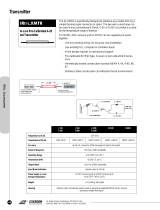 Exergen IRt/c.XMTR User manual
Exergen IRt/c.XMTR User manual
-
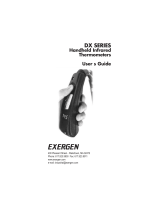 Exergen DX Series User manual
Exergen DX Series User manual
-
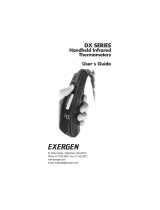 Exergen DX Series User manual
Exergen DX Series User manual
-
 Exergen DX Series User manual
Exergen DX Series User manual
-
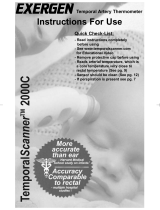 Exergen Temporal Scanner 2000C Instructions For Use Manual
Exergen Temporal Scanner 2000C Instructions For Use Manual
-
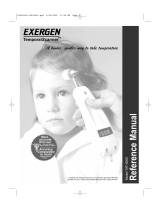 Exergen TAT-5000 User manual
Exergen TAT-5000 User manual
-
 Exergen TAT-5000S-TTL Infrared Thermometer User manual
Exergen TAT-5000S-TTL Infrared Thermometer User manual
-
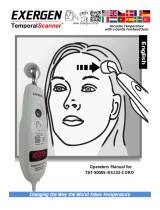 Exergen TAT-5000S-RS232-CORO Temporal Scanner User manual
Exergen TAT-5000S-RS232-CORO Temporal Scanner User manual
-
Exergen Instant Thermometry User manual
Other documents
-
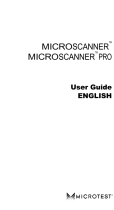 Microtest Microscanner Pro User manual
Microtest Microscanner Pro User manual
-
Omega RH200A & RH201A Owner's manual
-
Testo 835-H1 Short Instructions
-
Omega OS-88000-K-1200 Owner's manual
-
Omega OS36, O337, OS38 Owner's manual
-
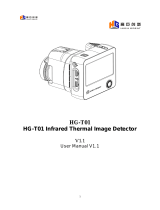 High Great HG-T01 Infrared Thermal Image Detector User manual
High Great HG-T01 Infrared Thermal Image Detector User manual
-
Omega OS35 User manual
-
Omega OS35 User manual
-
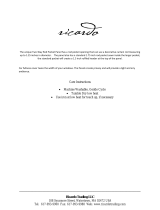 Ricardo Trading 03535-70-096-01 User manual
Ricardo Trading 03535-70-096-01 User manual
-
 Isotech milliK Precision Thermometer User guide
Isotech milliK Precision Thermometer User guide

















